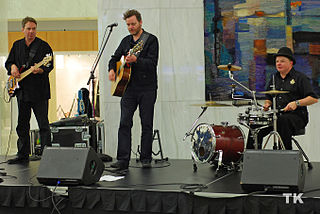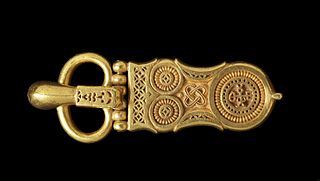
Henry Thomas Buckle was an English historian, the author of an unfinished History of Civilization, and a strong amateur chess player. He is sometimes called "the Father of Scientific History".

In a BDSM context, a collar is a device of any material worn by a person around the neck to indicate their submissive or slave status in a BDSM relationship. A person wearing a collar to symbolize their relationship with another is said to be collared. Some people conduct formal "collaring ceremonies", which are regarded as effectively solemnizing their relationship in a similar way as a marriage ceremony and the collar having similar significance as a wedding ring. The standard form of a collar is a black leather band around the neck, often with metal D-rings added to allow the attachment of a leash, rope or other restraints; but to be more discreet in public, some people may wear an ordinary choker or jewelry necklace for the same symbolic purpose.
Buckles is a comic strip by David Gilbert about the misadventures of an anthropomorphic naïve dog. Buckles debuted on March 25, 1996.

The buckle or clasp is a device used for fastening two loose ends, with one end attached to it and the other held by a catch in a secure but adjustable manner. Often taken for granted, the invention of the buckle has been indispensable in securing two ends before the invention of the zipper. The basic buckle frame comes in a variety of shapes and sizes depending on the intended use and fashion of the era. Buckles are as much in use today as they have been in the past. Used for much more than just securing one’s belt, instead it is one of the most dependable devices in securing a range of items.

A strap, sometimes also called strop, is an elongated flap or ribbon, usually of fabric or leather.

Kevin Hearn and Thin Buckle are a Canadian band consisting of Barenaked Ladies multi-instrumentalist Kevin Hearn as the front man, bassist Chris Gartner and drummer Great Bob Scott. The three had previously collaborated as members of the Canadian alternative rock band Look People. Guitarists Martin Tielli and Derek Orford were originally members; the former left the band to pursue other musical interests in the early 2000s, while the latter left due to injury shortly after the release of Night Light in 2004 and never returned to the band other than as a guest performer on four tracks of The Miracle Mile. Brian MacMillan joined the group on guitar and keyboards after Night Light was released, effectively replacing Orford. MacMillan left the group to pursue his own career after the recording of Havana Winter. Mike Rathke is credited as a member of the band on guitar on that album, although he has never performed live with the group. Sheena Ko began performing with the band in 2010 on keyboards and vocals.

An I-beam, also known as H-beam, w-beam, universal beam (UB), rolled steel joist (RSJ), or double-T, is a beam with an I or H-shaped cross-section. The horizontal elements of the "I" are known as flanges, while the vertical element is termed the "web". I-beams are usually made of structural steel and are used in construction and civil engineering.

Reins are items of horse tack, used to direct a horse or other animal used for riding. They are long straps that can be made of leather, nylon, metal, or other materials, and attach to a bridle via either its bit or its noseband.

A belt buckle is a buckle, a clasp for fastening two ends, such as of straps or a belt, in which a device attached to one of the ends is fitted or coupled to the other. The word enters Middle English via Old French and the Latin buccula or "cheek-strap," as for a helmet. Belt buckles and other fixtures are used on a variety of belts, including cingula, baltea, baldrics and later waist-belts.
Specific modulus is a materials property consisting of the elastic modulus per mass density of a material. It is also known as the stiffness to weight ratio or specific stiffness. High specific modulus materials find wide application in aerospace applications where minimum structural weight is required. The dimensional analysis yields units of distance squared per time squared.
Bernard Budiansky was a renowned scholar in the field of applied mechanics, and made seminal contributions to the mechanics of structures and mechanics of materials. He was a recipient of the Timoshenko Medal.
Paul John Buckle is an English football manager. He is currently Assistant Under 23 coach at Southampton FC. He has previously been the manager of Torquay United, Bristol Rovers, Luton Town, Cheltenham Town and Sacramento Republic.

Structural mechanics or Mechanics of structures is the computation of deformations, deflections, and internal forces or stresses within structures, either for design or for performance evaluation of existing structures. It is one subset of structural analysis. Structural mechanics analysis needs input data such as structural loads, the structure's geometric representation and support conditions, and the materials' properties. Output quantities may include support reactions, stresses and displacements. Advanced structural mechanics may include the effects of stability and non-linear behaviors.
In mechanical engineering, ultimate failure describes the breaking of a material. In general there are two types of failure: fracture and buckling. Fracture of a material occurs when either an internal or external crack elongates the width or length of the material. In ultimate failure this will result in one or more breaks in the material. Buckling occurs when compressive loads are applied to the material and instead of cracking the material bows. This is undesirable because most tools that are designed to be straight will be inadequate if curved. If the buckling continues, it will create tension on the outer side of the bend and compression on the inner side, potentially fracturing the material.

Frank Woodruff Buckles was a United States Army corporal and the last surviving American military veteran of World War I. He enlisted in the U.S. Army in 1917 at the age of 16 and served with a detachment from Fort Riley, driving ambulances and motorcycles near the front lines in Europe.

A rupture disk, also known as a pressure safety disc, burst disc, bursting disc, or burst diaphragm, is a non-reclosing pressure relief safety device that, in most uses, protects a pressure vessel, equipment or system from overpressurization or potentially damaging vacuum conditions.
In a nuclear reactor, criticality is achieved when the rate of neutron production is equal to the rate of neutron losses, including total neutron absorption and total neutron leakage. Geometric buckling is a measure of neutron leakage, while material buckling is a measure of neutron production minus absorption. Thus, in the simplest case of a bare, homogeneous, steady state reactor, the geometric and material buckling must be equal.

Shoe buckles are fashion accessories worn by men and women from the mid-17th century through the 18th century. Shoe buckles were made of a variety of materials including brass, steel, silver or silver gilt, and buckles for formal wear were set with diamonds, quartz or imitation jewels.

Skid boots are used to protect a horse's hind legs during exercise and competition, protecting the fetlocks, pasterns, and other parts of the lower leg from injury that may occur from a sliding stop. Taller varieties may also provide protection if one leg or hoof strikes the opposite leg. They are commonly seen on horses in western riding sports such as cutting, reining and other events where quick stops and fast turns on the hindquarters may be required.













